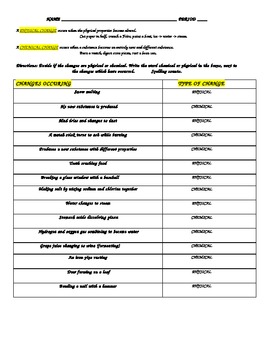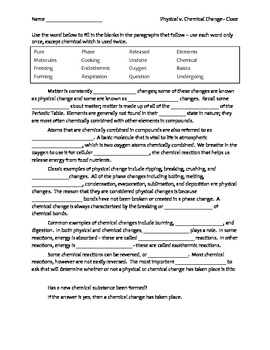Physical Or Chemical Change Worksheet With Answers
Changing the size and shapes of pieces of wood would be a chemical change. In a physical change, the makeup of matter is changed. Evaporation occurs when liquid water changes into a gas. Evaporation is a physical change. Burning wood is a physical change. Combining hydrogen and oxygen to make water is a physical change.

Changes: Physical or Chemical?Changes: Physical or Chemical?Reading LeveledHelper's suggested reading level:grades 5 to 8Flesch-Kincaid grade level:7.03Vocabularychallenging words:orangey-red, heated, burning, photosynthesis, original, electrical, substance, vinegar, plasma, microscope, undo, vapor, universe, ordinary, condense, gainPrint Changes: Physical or Chemical?Quickly PrintProofreading ActivityChanges: Physical or Chemical?By Cindy Grigg1 If you have studied atoms, you know that atoms are the building blocks of matter. Atoms are so small they cannot be seen with an ordinary microscope. Yet atoms make up everything in the universe. Atoms can combine with different atoms and make new substances.
Substances can also break apart into separate atoms. These changes are called chemical changes or reactions. Chemical reactions happen when atoms gain, lose, or share electrons. What about when water freezes into ice?
Do you think that's a chemical change?2 When water freezes, it has changed states. You probably already know about the four states of matter. They are solid, liquid, gas, and plasma. Plasma is the fourth state of matter and is the most common state in the universe. However, it is rarely found on Earth. Plasma occurs as ball lightning and in stars.
Water is a common substance that everyone has seen in its three states of matter. Water in its solid state is called ice. Water in the liquid state is just called water. Water as a gas is called water vapor.
We can easily cause water to change states by changing its temperature. Water will freeze at 32 degrees Fahrenheit (0 Celsius). However, no chemical change has occurred. The atoms have not combined or broken apart to make a different substance; it is still water or H 2O. When we heat water to a temperature of 212 F.
Or 100 Celsius, it will change into a gas called water vapor. Changes in states of matter are just physical changes.3 Some more examples of physical changes are tearing paper into smaller pieces, sharpening your pencil, and stirring sugar into water.
When you tear a piece of paper, it is still paper; it's just that the pieces are smaller. That is a physical change; a change you can easily see. When you sharpen your pencil, you have only caused a physical change.

The sharpener has cut off some of the wood and maybe also some of the graphite, but the atoms of the wood and graphite have not changed chemically. You might think that the shavings you find inside the pencil sharpener are a new substance, but chemically they are not. They are still wood and graphite in smaller pieces than the original. When you stir sugar into water, you have only caused a physical change. The glass still contains water and sugar, but they have been mixed together.
Is the sugar still there? Yes, you can taste it. This is only a physical change.Paragraphs 4 to 5:For the complete story with questions:Weekly Reading BooksPrepare for an entire week at once!Feedback on Changes: Physical or Chemical?MatterPhotosynthesisMore LessonsScienceCopyright © 2018 edHelper.
Chemical Vs Physical Change Worksheet
Name: POP QUIZ Physical and Chemical Change Multiple Choice Identify the letter of the choice that best completes the statement or answers the question. A ( Physical or Chemical ) change is a change of matter from one form to another without a change in chemical properties.
A ( Physical or Chemical ) change is a change that occurs when a substance changes composition by forming one or more new substances. True or False Color change is evidence that a chemical change may have occurred. True or False Fizzing or foaming is evidence that a chemical change may have occurred. True or False Production of sound is evidence that a chemical change may have occurred. True or False Production of heat or light is evidence that a chemical change may have occurred. True or False Production of an odor is evidence that a chemical change may have occurred.
True or False Chemical changes can not be reversed by physical changes. FalsePhysical Change- or -Chemical Change9. You cut your hair 10. Mixing sugar and water 11. Making a peanut, pretzel and cereal mixture 12.
Physical And Chemical Changes Class 7 Worksheet With Answers
Baking soda reacts with vinegar and forms a gas 13. A piece of metal is bent in half 14.
Methanol is burned and leaves a residue 15. An aspirin is crushed into fine powder 16. Copper turns green when exposed to the environment 17. Two clear liquids are mixed and a yellow color forms 18. Baking cookies 19. Diamonds are used to scratch glass 20. A tree burns to form ashes 21.
A piece of paper is crumpled up 22. Water freezes to form ice Define Physical Change:Define Chemical Change.